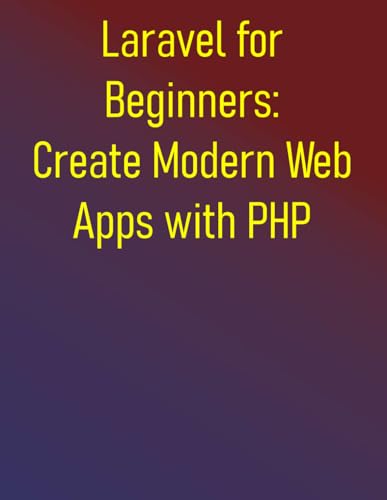Items related to Laravel for Beginners: Create Modern Web Apps with...
Laravel for Beginners: Create Modern Web Apps with PHP: Master PHP Web Development with Laravel Framework - A Hands-On Step-by-Step Tutorials for Beginners - Softcover

Synopsis
What you will learn :
- Understand Laravel Fundamentals: Grasp what Laravel is, its key features (like Eloquent ORM, Blade templating, and Artisan CLI), its benefits, and the Model-View-Controller (MVC) architectural pattern as it applies to Laravel.
- Set Up Your Development Environment: Learn to install PHP, Composer, Node.js, and configure a local Laravel development environment.
- Navigate and Configure Laravel Projects: Become familiar with the standard Laravel project directory structure, understand the importance of the .env file for environment configuration, and know where to find and modify application-specific configuration files.
- Master Routing: Define how your application responds to web requests by creating routes for various HTTP methods, naming routes for easy URL generation, grouping related routes, and passing data to controllers or closures.
- Utilize Controllers for Application Logic: Learn to organize your application's request handling logic within controllers, create controllers using Artisan, define action methods, connect routes to these actions, and pass data from controllers to your views.
- Craft Dynamic User Interfaces with Blade: Discover Laravel's powerful Blade templating engine to create reusable and dynamic HTML.
- Manage Your Database Schema with Migrations: Understand how to version control your database structure using migrations. You'll learn to create and run migration files to define tables, columns, indexes, and relationships, and how to populate your database with test data using seeders.
- Interact with Databases Fluently using Eloquent ORM: Learn the principles of Object-Relational Mapping and use Laravel's Eloquent ORM to easily interact with your database.
- Build and Query Data Relationships: Define and work with various types of database relationships (One-to-One, One-to-Many, Many-to-Many) between your Eloquent models, query these relationships efficiently, and learn about eager loading to prevent common performance issues.
- Handle Web Forms and User Input: Learn to create HTML forms using Blade, securely handle submitted data from various input types, manage file uploads, and repopulate forms with old input after validation errors.
- Implement Robust Data Validation: You'll learn to use a wide range of validation rules, display error messages effectively, and organize complex validation logic using Form Request classes.
- Use Middleware for Request Filtering: You'll learn to create your own custom middleware and register it to perform tasks like authentication, logging, or modifying requests and responses.
- Implement User Authentication and Authorization: You'll learn to protect routes, access authenticated user information, and implement basic authorization logic using Gates.
- Leverage the Artisan Console: You'll use it to generate boilerplate code (controllers, models, migrations), manage your database, inspect routes, clear caches, and even create your own custom commands.
- Manage Frontend Assets (CSS & JavaScript): Understand how Laravel integrates with frontend build tools like Vite to compile and manage your CSS and JavaScript assets, and how to include these compiled assets in your Blade views.
- Build a Complete Application: Consolidate your knowledge by building a simple but complete web application (e.g., a mini-blog or task list) from scratch, applying all the concepts learned throughout the book.
- Discover Next Steps and Advanced Topics: Get an introduction to further learning paths and more advanced Laravel features, including automated testing, queues for background jobs, events and listeners, building RESTful APIs, and exploring the broader Laravel ecosystem and community resources.
"synopsis" may belong to another edition of this title.
Search results for Laravel for Beginners: Create Modern Web Apps with...
Laravel for Beginners: Create Modern Web Apps with PHP: Master PHP Web Development with Laravel Framework - A Hands-On Step-by-Step Tutorials for Beginners
Print on DemandSeller: California Books, Miami, FL, U.S.A.
Condition: New. Print on Demand. Seller Inventory # I-9798285541424
Quantity: Over 20 available
